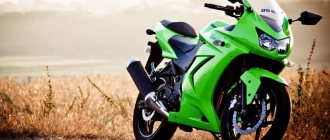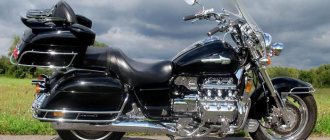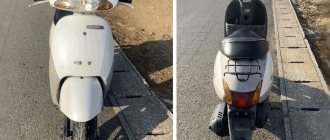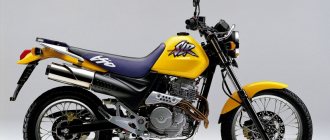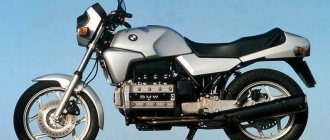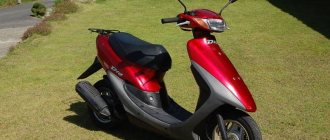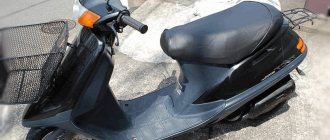Specifications
The “brainchild” of the land of the rising sun is famous for its 4-stroke OHC engine MF03E. Water cooling helps eliminate engine overheating. The maximum power of the scooter is 20 hp. The declared power is quite enough for city driving. The working volume of the gasoline engine is 244 cc. The engine is “powered” through the fuel system, through the VE40 carburetor.
The power unit is started by an electric starter and the ignition is electronic. The standard ignition type is CDI, that is, the operating principle is based on capacitor discharge. The main advantage of this ignition is the following: the resulting spark does not directly depend on the operation of the engine. The dimensions of the Japanese scooter are as follows: length 1840 mm; width 730 mm; height 1095 mm. The wheelbase of the vehicle is 1300 mm, and the seat height is 760 mm. Since the scooter was purposefully designed for driving on roads of good quality, the tire size is small: front 110/90-10 61J and rear 120/90-10 65J. The fuel tank capacity is 9.2 l, fuel consumption is 2.5 l/100 km. Dry weight of the equipment is 136 kg.
Honda PS-250 (Big Ruckus): off-road scooter (used)
The Honda PS-250 or Honda Big Ruckus 250 off-road scooter is a unique model of a Japanese all-terrain scooter, which has no analogues in the world, the production of which was carried out from 2010 to 2010. This modification optimally combines the aggressive dynamics and cross-country ability of a light enduro motorcycle with the practicality and comfort of a city maxi-scooter.
Like the previous, “younger” modification (Honda Zoomer AF-58), the PS-250 version was made on the basis of a lightweight but durable tubular frame, without unnecessary external cladding. In addition, the scooter was equipped with large wheels with off-road tires. In Japan, this scooter was produced as the PS 250, and in North America, in the US and Canadian markets, it was introduced as the Big Ruckus 250.
Good aerodynamics, an impressive (1455 mm) wheelbase, a powerful (19 hp) four-stroke liquid-cooled engine with a single cylinder capacity of 250 cm³, on a comfortable highway allow the scooter to develop a maximum speed of more than 150 km/h. At the same time, with a total weight of 172 kg, a gasoline injection engine will need no more than 3.3 liters of AI-95 fuel per 100 km of travel.
The Japanese all-terrain scooter Honda PS-250 is ideal for traveling on paved roads, city streets and country roads. This scooter is convenient for traveling both short and long distances. The soft seat has a folding backrest, which can be brought to a horizontal position and can accommodate a passenger behind the driver's back.
In our online store you can buy a used Honda Big Ruckus 250 scooter in Moscow or order its delivery from Japan. All used scooters are guaranteed to undergo full brand diagnostics and thorough pre-sale preparation. In motorcycles imported from Japan, all operating fluids are replaced with new ones, and other consumable parts are also replaced.
A number of scooter parts are subject to mandatory replacement: battery, tires, brake pads, spark plug, air and fuel filters, counterweights and variator belt, clutch plate, as well as operating fluids (motor and transmission oils, coolant and brake fluids). The final price of each scooter depends on the year of its manufacture, mileage and condition.
The off-road maxi-scooter Honda Big Ruckus 250 can be ordered upon request with delivery from Japan. To do this, you will need an advance payment of 50% of the total cost of the SUV, the amount of which will depend on the parameters you stated (year of manufacture, mileage, etc.), and a month of waiting. We provide service and warranty for Japanese motorcycles purchased from us.
Appearance and equipment
The appearance of the scooter can be safely called “standard”. All power units (scooter frame, engine and other units) are carefully hidden with durable and flexible plastic. The model range of Honda scooters at that time was similar to each other; there were no special differences between the scooters. Honda Freeway 250 is a two-seater model with a comfortable seat. With the naked eye, you can see a large handle for the passenger at the rear, which can be said to “help out” at high speeds. A trunk is mounted immediately behind the seat near the brake light, the load on which should not exceed 5-10 kg. In front, under the steering wheel, there is a small compartment for small items. On the same steering wheel, side mirrors are installed on the side, which allow you to drive in the city under control.
Like other scooters, this model has an automatic transmission (V-Matic CVT). Due to this, a teenager and even a child can drive the Honda Freeway. The lightweight steering also contributes to this. The instrument panel contains a speedometer, fuel and oil gauge.
There is a spacious luggage compartment under the seat, into which you can place the necessary tools and various “useful things”. At the front of the MF-03 there is a headlight that provides reliable illumination of the road surface at night. The suspension on this scooter is as follows: a telescopic fork is installed at the front, and a pendulum suspension at the rear. On minor bumps and shallow holes the equipment behaves very well, but off-road travel is out of the question. The scooter was primarily designed for measured driving on high-quality roads in Japan. Due to the small diameter of the wheels, “falling” into a deep hole can end very badly. Also, driving on dirt roads tends to loosen the fasteners that hold all the plastic together.
Let us remind you of the braking system, which consists of discs at the front and drums at the rear.
Hi all! My first test ride of the Honda dio received a lot of positive feedback. Many people became interested in the Honda Foresight, my first maxi-scooter. Wanted - get - sign: History of the model.
The Honda Foresight FES250 scooter began production in 1995 and was, in fact, the first utilitarian maxi-scooter in the modern sense in the Honda line. Before that there was the smaller Freeway and the longer Fusion tourer. But there were no universal, sufficiently powerful, but at the same time compact cars, well suited for everyday driving, as a complete replacement for a car in warm countries.
In 1998, Foresight was modernized and the FES250SE model appeared. It has a rear disc brake and a combo-brake system (you brake with the rear brake, but in addition to the rear one, one of the front caliper pistons also works and the car also brakes with the front one). We also changed the seat and made it softer. In 2005 they changed the headlight and some other little things in the design. Foresight is not particularly popular with us; many people find its design controversial, and its dimensions are small for a maxi-scooter. However, in the world the model was appreciated by those who care not about show-off, but about a successful, balanced and reliable scooter for everyday use.
Personal experience.
I started the force with a fifty-kopeck Honda Dio AF28. When we first met, the scooter simply amazed us with its size! It seemed that I was sitting astride a fifty-kopeck piece, but in Foresight I had to climb “inside.” I remember how the difference in weight stood out to me when I pushed it off the step. But while moving, the scooter instantly lost all its weight and, in principle, was not much different from a fifty-kopeck scooter in terms of handling. I was also struck by the dynamics; after a test drive, I realized that at half throttle all this time I was the “whipping boy” on the road.
I constantly had to think about how to turn, how to fit into the highway traffic, which roads to avoid, etc. Here you just drive, like in a car. And you are not afraid that the speed may not be enough. In the city, 120 maximum speed is quite enough, even on the Moscow Ring Road. The dynamics are comparable to my Ford Focus 1.6 with automatic transmission. Somewhere in tests I saw a figure of 12 seconds to 100 km/h. – very similar, although I didn’t measure it myself. However, the nature of acceleration is shifted to the bottom. Up to 60 km/h the scooter accelerates very vigorously, about like a 1.6-1.8 car with a stick. Then it begins to slowly but surely drain. One way or another, in the city this is quite enough, even if some driver proudly overtakes you after 100, in a damn minute you will whistle past him in the aisle in front of the traffic light.
The scooter also impressed with its luggage capacity. I am regularly reminded of this by everyone who saw my device for the first time - “Figase toilet!” He's really healthy. Its volume is 40 liters and it is well profiled. The lid tilts to the side, which is also very convenient and makes loading easier. I personally fit a full-size integral helmet, knees, a 0.5 liter water flask, a foot pump, an anti-theft cable, an empty backpack, a set of tools, a first aid kit, a bottle for repairing tubeless tires and a full manual. Not sour, right? There’s also the original case, which you can pack your motorcycle jacket into if you try hard enough. Also, there are two glove compartments in front, one of which is locked with a key. But only a pack of cigarettes and tissues will fit there. Be that as it may, Foresight is one of the leaders in terms of luggage. For example, when I went to a festival in Suzdal, I wore shorts, a T-shirt, sandals and one motorcycle boot in my backpack. We managed to stuff the full set of other protection into the available luggage containers. I also like the wind protection of the scooter. On fifty dollars I moved at much lower speeds, but I had to dress much warmer. Here the glass very competently disperses all the cold currents and in the summer you can even drive in a T-shirt. The scooter's glass is mounted on the handlebar and rotates with it, so you are always protected from the oncoming wind.
I am regularly reminded of this by everyone who saw my device for the first time - “Figase toilet!” He's really healthy. Its volume is 40 liters and it is well profiled. The lid tilts to the side, which is also very convenient and makes loading easier. I personally fit a full-size integral helmet, knees, a 0.5 liter water flask, a foot pump, an anti-theft cable, an empty backpack, a set of tools, a first aid kit, a bottle for repairing tubeless tires and a full manual. Not sour, right? There’s also the original case, which you can pack your motorcycle jacket into if you try hard enough. Also, there are two glove compartments in front, one of which is locked with a key. But only a pack of cigarettes and tissues will fit there. Be that as it may, Foresight is one of the leaders in terms of luggage. For example, when I went to a festival in Suzdal, I wore shorts, a T-shirt, sandals and one motorcycle boot in my backpack. We managed to stuff the full set of other protection into the available luggage containers. I also like the wind protection of the scooter. On fifty dollars I moved at much lower speeds, but I had to dress much warmer. Here the glass very competently disperses all the cold currents and in the summer you can even drive in a T-shirt. The scooter's glass is mounted on the handlebar and rotates with it, so you are always protected from the oncoming wind.
Immediately under the glass there are two air intake holes, which cleverly redirect the incoming air. Here I will quote one of the third-party testers:
In front, under the glass, there is an air intake that directs the air flow not onto, but under the windshield, so that a vacuum does not form behind it. Thanks to this, the flows of incoming air are not “perturbed” and do not form unnecessary turbulence. Exactly the same air intakes are also on the fairing.
It’s not very clear about “extra turbulence,” but it’s a fact that the ride is comfortable and the air can only be felt on your hands. By the way, tuning glass is available for foresight, which expands above and below, creating wind protection for your hands. Like the well-known protective shields on endurikes, but more convenient, since they are not mounted on the handles and there is more space for hands operating the levers.
My wife likes the passenger seat - it is spacious, the passenger sits much higher than the pilot and sees everything that is happening in front of the bike. There are wide comfortable handles on the sides, and full (not folding) wide rubberized platforms at the feet. The original case has a soft back (although, taking into account the weight limit of 10 kg on the trunk, you can’t really recline on it).
The ride is comfortable, the suspension seems to handle bumps well (an unnoticed speed bump at medium speed will of course be noticeable, but not catastrophically) and the scooter handles well. Although, to be fair, I drive calmly and I don’t need the opportunity to scrape the running board along the asphalt when turning. The rear shock absorber is adjustable, and the range of adjustments is quite wide (5 positions). The landing is chopper - the legs are extended, there is not enough room for them (height is 180 cm), it is comfortable even in high motorcycle boots.
The tidy is simple - speedometer, fuel gauge, temperature gauge, clock, odometer (total mileage and resettable), maintenance timer. The instrument panel is easy to read and has a boring but high-quality backlight.
Both disc brakes (I have the same SE modification), combined. As a result, the rear brake is the main one, unlike most two-wheeled vehicles. I use the front one as an emergency when I need to stop right away. On the left lever there is a mechanical handbrake, a generally useful thing, in the case of a traffic light on a hill, for example. But the implementation is pretty idiotic. You need to press the button in front of the lever and fully squeeze the brake lever. Some kind of garbage engages with the stopper, and the lever itself moves back. To remove it, you need to press the lever all the way in again and the handbrake will release. Maybe it’s due to the age of the technology, but for me all this is accompanied by a lot of effort, no matter how I lubricated this unit. As a result, there were a couple of situations when the green light suddenly turned on, I pressed the lever, started and realized that I had not released the handbrake. And there’s traffic coming from behind, and in order to get off I have to stop completely, which is not easy in the left lane. In general, I don’t understand why it was not possible to make a simpler system, like on DIO. Stupidly a bracket that blocked the brake lever itself, and not some garbage in the bowels of the brake mechanism.
There is also a cool feature with an automatic turn signal switch. There is something like a tilt sensor there. I turned on the turn signal, entered a turn, straightened the bike - the turn signal turns off. The system works so reliably that I don’t turn off the turn signal manually at all; it always turns off on its own when needed.
The gas tank is on the tunnel, behind the hatch with a lock, there is also the filler neck and the coolant level. It is convenient to refuel, without any distortions with the neck under the saddle.
The design of the device is the most controversial point, in my opinion. On the one hand, the scooter, despite its age, looks quite modern. Thanks to the headlight a la Honda blackbird and rear optics, stylistically very similar to the “tail” of old Cadillacs.
The side silhouette is lean, without the modern flared wings in the front. But I personally don’t like that very rotating “burdock” of the windshield. Because of this, the scooter from some angles looks like an undignified oversized fifty-kopeck piece. Most of them are characterized by just such a layout.
At the same time, judging by the tests (see articles below), some people, on the contrary, like this feature. For me, functionality triumphed over design...
Next to Burman:
The dynamics were mentioned above, I’ll just say that in comparison with the SYM GTS250 East, I got the impression that the 0-60 of the Foresight is faster, the factory Sim had some kind of failure there, according to the owner. But the maximum speed was a little higher. Now East has installed a new valve and now I drain it at the start. Although, again, everything is subjective. Exact measurements were not taken. The maximum speed on my speedometer was 130 on the highway, after a long and tedious acceleration. But I’m lightweight (60kg), so I suspect it won’t trample so much under everyone.
It was after purchasing Forsyth that my real motorcycle life began. The power of the device was already enough to ride on equal terms with light motorcycles on short trips. It was on the foresight that I made my first long-distance trip to Belka.
So there you go. Overall, I'm happy with the scooter. Most of the complaints are related to the design and cubic capacity (which has nothing to do with the scooter itself; the same can be said about any scooter). I would like a little more dynamics and maximum speed. And so - the device is excellent. If we draw parallels with the auto world, it can be compared to some Toyota Corolla. Reliable, practical, moderately cute machine without any special complaints. Passers-by won't turn around on the street, but you will drive every day for many years. And only spend money on consumables and gasoline...
I sold Forsyth with a squeaking heart and still remember this sad moment:
Okay, you should never regret what has passed. We should be glad that it happened. I'm glad I had Foresight!
Some interesting facts about the model:
— An exact copy of the Honda Foresight has been produced since 1999 in France under the Peugeout SV250 brand (note the lion emblem under the glass in the photo below). This is the only Honda model produced under a different name (and the most reliable Peugeout scooter :)).
— The design of the scooter was so successful that several more models were produced on its basis, differing from its progenitor mainly in appearance:
Honda PS250 Big Ruckus
Honda Forza
Honda Phanteon (less powerful and less successful 150cc and 125cc engine)
— Honda Foresight is widely used by the Spanish traffic police.
Please note - the aforementioned tuned extended windshield...
... headlight after restyling and transparent side lights on the front shield (mine are orange, like on old American cars).
— The cunning Chinese have released their 150cc copy of Foresight — Huatian ht150t-15
Interesting links on the model:
— Top gear issue dedicated to Honda Foresight (English)
Thanks for your attention, sorry it's long. Brevity has never been the sister of my talent.
Repair
Even with the most careful use of the scooter, breakdowns cannot be avoided. As a rule, the suspension system, CPG and variators (rear and front) suffer. It is also considered painful to select new plastic if the scooter falls. This is perhaps the biggest problem with all Japanese scooters from the 90s. The search and selection of new spare parts does not always end successfully. It is very difficult to find new components for a scooter that is more than 20 years old. Of course, you can buy spare parts at the market or a specialized store, but not original ones. The country of origin of such products is China, the quality of which leaves much to be desired. Based on this, we can draw the following conclusion: you need to think several times about what the right thing to do is buy a “Japanese” with many years of experience or a new “Chinese”.
Honda Forza 750 2021 Dual Clutch Transmission
2021 Honda Forza 750
The big news is, of course, the new Honda Forza 750. The older model is powered by a superb 745cc engine with a dual-clutch automatic transmission. This transmission combines the best of both worlds and allows you to change gears both automatically using several algorithms and manually using buttons on the steering wheel. At the same time, the ride feels more like a manual transmission due to real gear changes, which allows the driver to be more involved in the driving process.
Features of the 2021 Honda Forza 750 DCT
- 22 liter seat pannier
- Motorcycle-type brakes with ABS: dual 315mm discs at the front with radial-mounted four-piston calipers
- Motorcycle chassis
- Inline two-cylinder engine with a displacement of 745 cc. cm
- Full color 5" LCD instrument panel with customizable layout
- Connect with your smartphone and control calls, mail, music and navigation on the go - with your voice and the left steering wheel remote control (Android devices only)
- Three riding modes
- Six-speed dual-clutch automatic transmission
- The Smart Key system provides keyless entry, control of the steering wheel lock, tank lid, seat case lock, and the optional Smart Top Box.
- ESS system - automatic flashing of the brake light during heavy braking
- Automatic turn off of direction indicators
- Full diode lighting technology
- The 13.2-liter tank provides a range of up to 370 km.
Engine
Time-tested in-line twin with a displacement of 745 cc. cm with 8 valves with TBW - Throttle By Wire, that is, electronic gas, which allows you to implement three factory driving modes - Standard, Rain and Sports, as well as a fourth - a customizable user one, in which, in addition to the characteristics of the engine, the gear shifting character is also adjusted - aggressive or economical. The full-power version of the Honda Forza 750 produces 56 hp from the crankshaft; a version with a power limit of up to 46 hp from the crankshaft is also available - for junior categories of driving licenses. The restriction is set and removed programmatically at a Honda dealer.
Traction control
HSTC (Honda Selectable Torque Control) has three levels of intervention and can also be switched off completely.
2021 Honda Forza 750 chassis
A diagonal steel tube frame, 41mm inverted fork, lightweight aluminum swingarm, and Pro-Link adjustable rear monoshock provide the Honda Forza 750 with excellent handling on par with motorcycles. The front wheel measures 17 inches and the rear wheel measures 15 inches.
Luggage capacity
The Honda Forza 750 seat case can accommodate a full-face helmet. There is a USB socket for charging devices at the rear of the seat area, and there is an additional glove compartment on the right side of the front fairing.
Options
As an option on the Honda Forza 750, a central Smart Top Box with a capacity of 50 liters is available, which automatically opens in the presence of the driver, and side cases with a capacity of 26 (right) and 33 (left) liters. Internal bags are available for all three panniers, as well as a center console bag. For colder weather, heated grips are available (with all necessary wiring included), as well as foot deflectors. All of these products are available separately.
